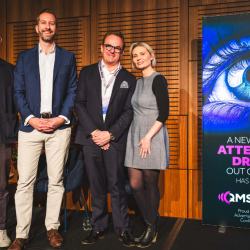It’s pretty safe to assume that we’ve all seen that Zara ad
The retailer’s latest campaign sparked outrage for its parallels to the ongoing conflict in Gaza. The now-pulled editorial features model Kristen McMenamy posed alongside limbless mannequins, debris and a cutout comparable to Palestine’s map. In one shot, she shoulders a statue wrapped in white fabric. It’s an image that critics insist reflects Islamic burial shrouds so closely, the resemblance must be intentional.

‘There is a sinister depravity in the commercial mind that produced this ad while we are living a real time genocide,‘ writes Palestinian artist Hazem Harb on Instagram. ‘Boycott Zara.’ This rallying call echoed across all corners of social media; #BoycottZara trended on X, and media intelligence firm CARMA reported Zara’s brand sentiment have dropped by -76.4%.
Since the campaign’s launch, the retailer’s Instagram account is down by 300,000 followers, and protests at Zara stores spanned from Glasgow to Melbourne.
For many netizens, Zara’s apology has only rubbed salt in the wound. In a statement issued on 12 December, the brand said the campaign, conceived in July, was created to solely showcase their product in an artistic context. ‘Unfortunately, some customers felt offended by these images […] and saw in them something far from what was intended […] Zara regrets that misunderstanding.‘ For marketers, that misunderstanding mystifies. Even if the ad was shot in the summer, months have passed for someone — anyone — at Zara to connect the campaign to current events and suggest pulling the plug.
How did an entirely avoidable blunder go unchecked? Who approved this?
Purpose and shifting priorities
This is not the first time that a brand has missed the mark. Just last month Marks & Spencer landed in hot water after some thought a shot of burning paper hats from their Christmas ad resembled the Palestinian flag.
Users across X have likened Zara’s controversy to last November’s Balenciaga child ad scandal, and Dolce and Gabbana are still struggling to repair their image in China five years on from this condescending 2018 campaign.
Beyond the world of fashion, this year’s marketing blunders shed light on another concern. Has purpose-led marketing’s seminal moment in the sun overshadowed basic brand building? Are we sure we’re even getting purpose right? In 2019, Procter and Gamble ex-CMO Jim Stengel warned that many marketers conflate cause with purpose, linking brands with social causes or collaborations that don’t align. However noble a brand’s social conscience may be, this short-term focus often leads to brand positioning that’s less refined and thus, less resilient to potential missteps. In our pursuit to do good, have we eclipsed our ability to effectively listen?
The economy right now is nebulous. UK households are struggling to stay afloat; recently The Independent reported that three times as many people endured food scarcity this October than during the pandemic. Soaring mortgage, rent and energy prices are choking household budgets. In their Causes that Count 2023 report, Revolt identified the public’s top 50 concerns: ‘Climate change’, which dominated in 2022, dropped to fourth place. ‘Access to healthcare’ and ‘unemployment and job security’ made the top three, and ‘poverty, hunger and homelessness in my country’ surged 11 slots to first place. Environmentalism remains tantamount, but it’s clear that issues with immediate, personal impact are taking precedence.
Are brands failing to read the room? Between lofty social causes and tone-deaf ads, the actual concerns of consumers remain unaddressed and seemingly misunderstood. Have we become so preoccupied with scattergun wins, rushing to ride the coattails of another brand’s success, that we’ve lost sight of what matters?
Great marketing is not about following trends; it requires a cultural stethoscope to listen to the beating pulse of society. Our world is increasingly interconnected, and doing well in these dynamic markets demands a deft grasp of prevailing global sentiments. Brands need to show that they care; they must understand who their customers are today and connect with them authentically or risk alienation.
Communication and cultural literacy
We know that communication is the cornerstone of marketing. It separates confusion and clarity, and bridges the gap between businesses and people. In this transaction brands bear the responsibility of cultural literacy. Companies who truly care will not only ensure that their messages resonate authentically, but crucially, do the research to avoid causing inadvertent offence.
- Semiotics, the study of signs and symbols, is a crucial tool in decoding cultural nuances. Human culture is made up of signs formed through our social and cultural backgrounds, and semiotic methods allow marketers to interpret how diverse audiences might instinctively decode campaigns.
- Cultural Intelligence (or CQ) is another strategic imperative. Ipsos’ 2022 meta-analysis revealed that only 31% of globally-tested ads performed consistently across markets. Translating campaigns is not enough. Brands must stay attuned to the socio-political context and sensitivities of the markets they operate in.
A commitment to care
These are only two examples of how brands can demonstrate their commitment to authentic connection. Ultimately, consumers want to know that brands care. That requires more than superficial gestures or fleeting collaborations tied to the latest social cause. Zara’s blunder is a stark reminder for brands to not only actively listen, but to remember that missteps are an opportunity for genuine reflection and apology. In an era of hyper-connectivity and cancellation, all are held accountable for everyone to see. Sincere apologies can serve as a bridge to rebuild trust with consumers; a chance to be bold, to cast aside the generic damage-control copy, and forge an authentic, memorable moment of connection with a discerning audience.
Customers are no longer loyal to a brand, but the experiences they get with that brand. In this way, brand loyalty is an ongoing process earned through sustained commitment to care. The brands that will succeed are those that proactively engage in the cultural dialogue, demonstrating a willingness to evolve and learn. To read the room, brands must listen, adapt and leverage culture to create thoughtful, nuanced experiences that resonate with the people they want to reach.
Featured image: Clem Onojeghuo / Unsplash






























